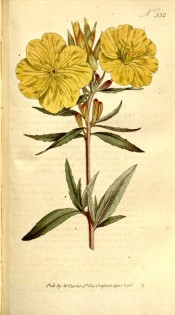Oenothera fruticosa L.
Fully hardy, erect perennial or biennial with branched, red-tinged, hairy stems, ovate to lance-shaped, toothed leaves, to 11cm long, and deep yellow saucer- to cup-shaped flowers opening during the day from late spring to late summer. To 90cm. [RHSE, Hortus].
Horticultural & Botanical History
‘The present species in some respects deviates from the others, the root is perennial, the flowers which are large and shewy, though they open in the evening, remain expanded during most of the ensuing day; the flower buds, the germen, and the stalk are enlivened by a richness of colour which contributes to render the species one of the most ornamental and desirable of the tribe. […] Cultivated in 1737 by Miller. [BM t.332/1796]. Paxton’s Dictionary lists two varieties. The variety indica is figured in the Botanical Register, obtained as part of a collection of old European and American plants originally sent to India from England, and then returned. [BR f.11/1841].
History at Camden Park
Listed in the 1845, 1850 and 1857 catalogues [H.163/1845].
Notes
Published Oct 12, 2009 - 02:58 PM | Last updated Jul 28, 2010 - 03:35 PM
| Family | Onagraceae |
|---|---|
| Category | |
| Region of origin | North America |
| Synonyms | |
| Common Name | Shrubby evening primrose, Sundrops |
| Name in the Camden Park Record | Oenothera fruticosa |
| Confidence level | high |
